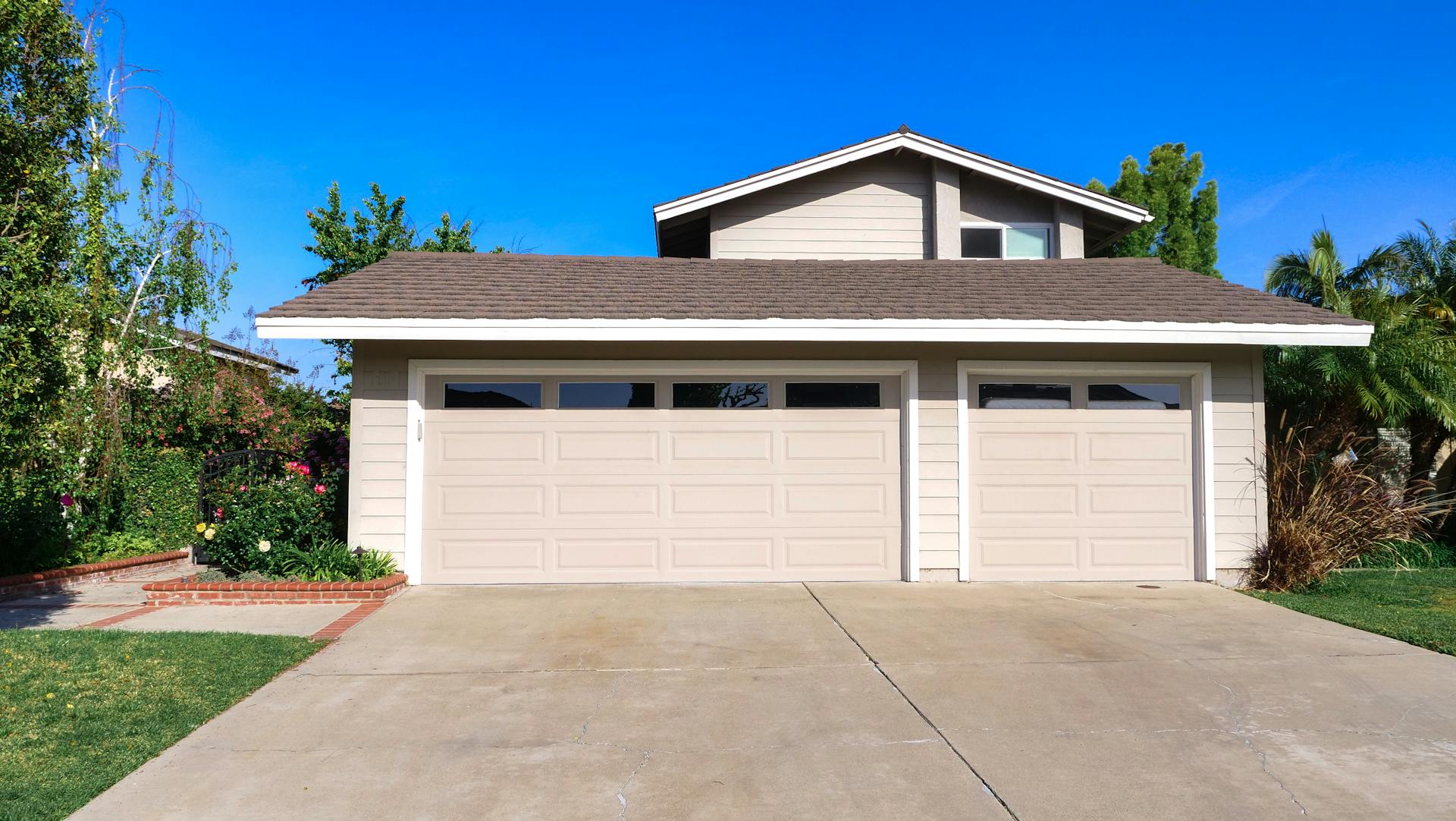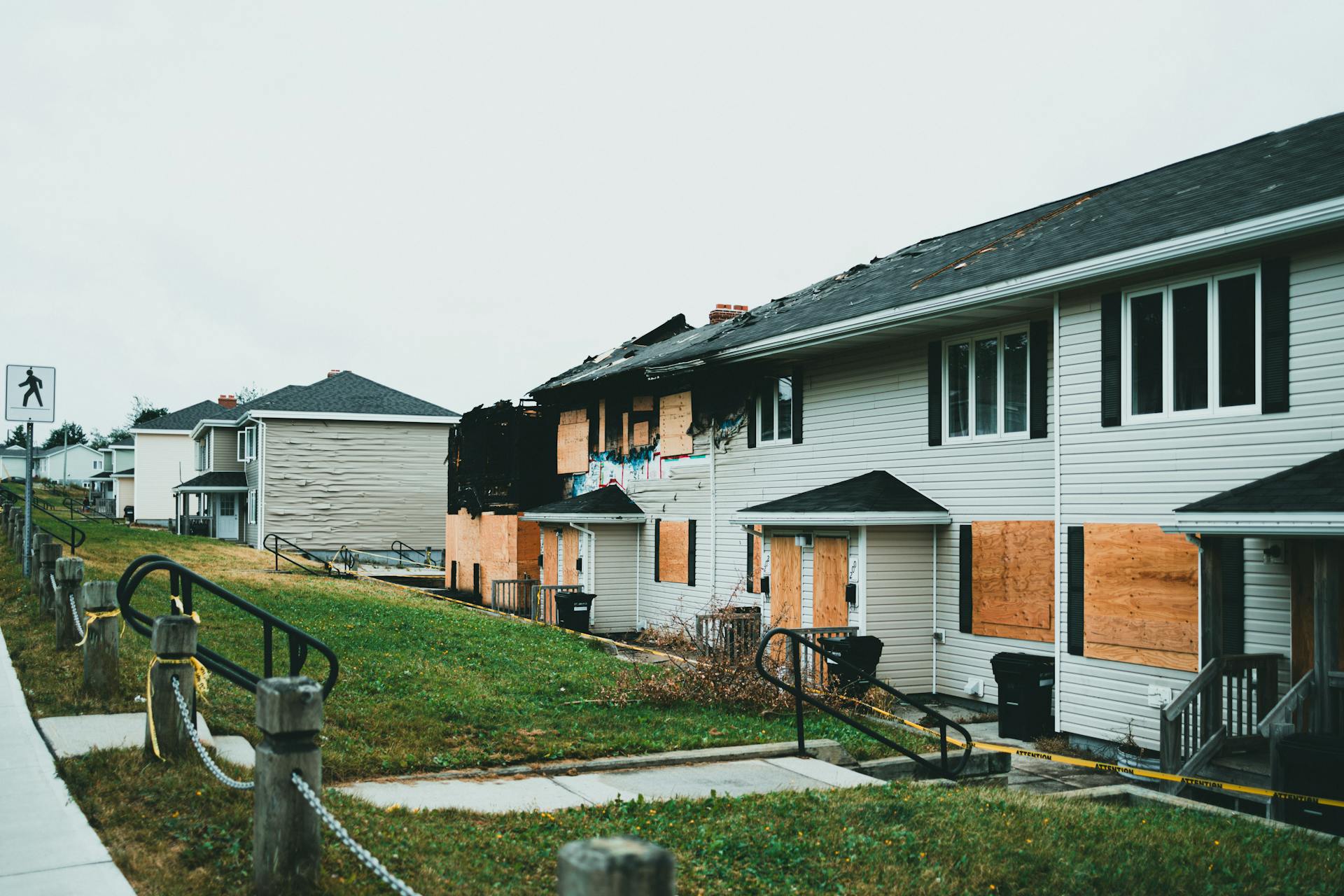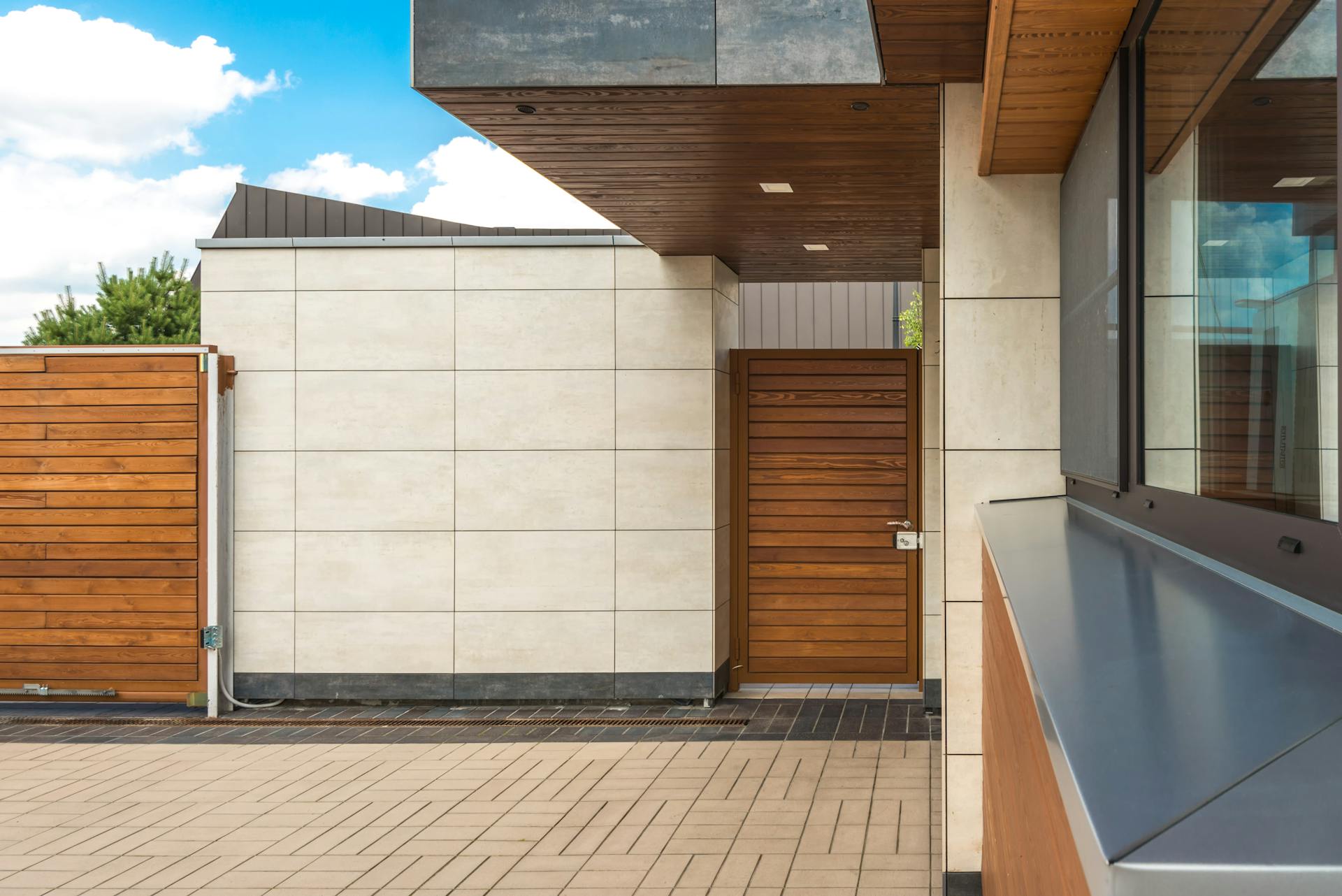
Home insurance can be a lifesaver in case of unexpected events, but it's essential to understand what's covered and what's not. Most home insurance policies cover damage to exterior features like siding, but the extent of coverage varies.
Typically, home insurance policies include a section for dwelling coverage, which covers damage to the home's structure, including the siding. However, the policy may not cover damage from normal wear and tear or maintenance-related issues.
Some home insurance policies may also offer additional coverage for specific types of siding damage, such as wind damage or hail damage. It's crucial to review your policy and check with your insurance provider to understand what's covered and what's not.
You might like: What Does Health Insurance Not Cover
What to Know
Some states have laws that require insurers to replace all siding, even undamaged areas, with new siding if it's necessary to match.
Ohio, Kentucky, and Iowa are examples of states with matching siding laws for insurance carriers. This means that if you live in one of these states, your insurer may be required to replace all your siding, even if only a small area is damaged.

The type of coverage you have in your policy will affect how your siding replacement is covered. Dwellings are usually covered on a replacement cost basis, which means your insurer needs to replace your stuff sufficiently.
If you have actual cash value coverage for your dwelling, your insurer may not be as willing to replace all of your siding if you experience a partial loss. This is because actual cash value coverage factors in depreciation, which means you'll receive a smaller payout the older your siding is.
HO8 policies, or insurance plans for older homes, are more likely to have actual cash value coverage for dwellings. If you have one of these policies, you may be more likely to encounter a scenario where your insurer doesn't replace all your siding.
Causes and Risks
Siding can be susceptible to various forms of damage, including weather damage from strong winds, heavy rain, hailstorms, and extreme temperatures.

Weather damage can lead to cracks, dents, and even detachment of siding. Insect infestation, such as termites, can also cause structural damage and weaken the material.
Fungal growth is another risk, promoted by moisture and humidity, which can lead to discoloration, rot, and decay. Impact damage from accidents, falling debris, or landscaping equipment can also cause dents, scratches, and punctures in siding.
Here are some common causes of siding damage that may be covered by your home insurance policy:
- Storms: Strong winds, hail, and other severe weather conditions can damage siding.
- Falling Objects: Damage caused by falling trees, branches, or other objects can be covered.
Causes and Risks
Storms can cause significant damage to your home's siding, often resulting in cracks, dents, or even detachment. Windstorms, including hurricanes and tornados, are typically covered under your homeowners insurance policy.
Siding can be susceptible to various forms of damage, including weather damage, insect infestation, fungal growth, and impact damage. Weather damage can occur due to strong winds, heavy rain, hailstorms, and extreme temperatures.
Termites and other insects can infest wood siding, causing structural damage and weakening the material. This can lead to costly repairs down the line.

Fungal growth on siding can be caused by moisture and humidity, resulting in discoloration, rot, and decay. This can compromise the integrity of your home's exterior.
Accidents, falling debris, or even landscaping equipment can cause dents, scratches, and punctures in siding. These types of impact damage can be costly to repair.
Here are some common causes of siding damage that may be covered by your home insurance policy:
- Storms: Strong winds, hail, and other severe weather conditions can damage siding.
- Fire: A house fire can cause extensive damage to siding.
- Vandalism: Intentional acts of vandalism, such as graffiti or physical damage, are typically covered by home insurance.
- Falling Objects: Damage caused by falling trees, branches, or other objects can be covered by your insurance policy.
Types of Materials
When choosing a siding material, it's essential to consider the risks and potential costs associated with each option. Vinyl siding, for instance, is generally more affordable and easier to replace than wood siding.
Vinyl siding is a popular choice due to its affordability and low maintenance requirements. It's available in various colors and styles to match different architectural designs. Vinyl siding is also more prone to damage than other materials, which can impact your insurance coverage.
Fiber cement siding, on the other hand, offers superior fire resistance and durability, making it a long-lasting option. It's also resistant to moisture and insects, reducing the risk of damage and costly repairs.

Here's a brief comparison of common siding materials:
Wood siding, while offering a classic and timeless look, requires regular maintenance to prevent rot and decay. This can be a significant risk factor, especially if you're not willing or able to perform regular upkeep.
Brick siding, on the other hand, offers a robust and elegant appearance, with minimal maintenance requirements. However, it can be more expensive than other options, which may impact your budget and insurance coverage.
Stone siding provides a unique and luxurious look, but it's also the most expensive siding material. Its durability and long-lasting nature make it a worthwhile investment for some homeowners, but it may not be feasible for others.
A unique perspective: Household Insurance Cover
Home Insurance Coverage
Home insurance coverage for siding damage can be a bit tricky, but it's generally covered under the dwelling coverage in your policy.
Your insurer's responsibility is to bring the damaged property back to its initial condition with materials of similar condition and quality. This means they should replace your siding with new siding that's similar in quality and condition to the old one.
However, getting new siding to match the existing siding on your house can be a challenge, especially if the old siding has faded or weathered over time. This is because "similar" siding might not cut it on the outside of your house, and it could reduce the value of your home.
The type of policy you have, the cause of the damage, and the details of your insurance agreement will all impact the specific coverage and payout for siding damage. Your insurer may have to decide whether to restore just the damaged part of your home or replace all of your siding with new siding.
If all of your siding needs to be replaced, the claim may be more straightforward, but partial damage can be a bigger headache. Your insurer's duty is to bring your home back up to pre-loss condition, which means getting new siding that matches the old siding can be almost impossible if the existing siding has been discontinued.
Policy and Claims

Your home insurance policy will have specific limits on the amount of coverage available for siding damage, which is typically a percentage of your home's overall insured value. This limit will be crucial in determining how much of the damage will be covered by your insurance.
The deductible is the amount you'll need to pay out of pocket before your insurance coverage kicks in, and it's usually around $1,000. For example, if your deductible is $1,000 and your siding damage costs $5,000, you'll pay the first $1,000, and your insurance will cover the remaining $4,000.
Documentation and evidence are essential when filing a claim for siding damage, and they can include photos, videos, repair or replacement estimates, police reports, and weather reports. These documents will help you build a strong case for your claim and increase the likelihood of a fair settlement.
Here's a quick rundown of the types of documentation you may need:
- Photos and Videos: Capture clear photos or videos of the damaged siding from different angles and close-ups.
- Repair or Replacement Estimates: Obtain estimates from reputable contractors for repairs or replacement of the damaged siding.
- Police Reports: If the damage was caused by a theft or vandalism, obtain a police report.
- Weather Reports: If the damage was caused by a storm, obtain weather reports from the date of the incident.
Policy and Claims

Matching coverage home insurance endorsements can be added to your policy to cover the cost of replacing undamaged siding to match new, replacement siding after a covered loss.
This extra coverage typically costs a little extra per policy term, but it can give you peace of mind knowing you won't have to worry as much about siding damage insurance claims.
Some insurers will let you choose a limit for matching siding coverage, while others will have a fixed amount they'll provide in case it comes up. For instance, if you have $30,000 of matching siding coverage, you should be good to go as long as the job to replace all of your siding costs less than $30,000.
The availability of matching coverage varies by carrier, and some insurers may have age or material restrictions. For example, you may only be able to get matching home insurance coverage with vinyl or aluminum siding.
If this caught your attention, see: Which Insurers Offer 180 Car Insurance European Cover

To get insurance coverage for your new siding installation, you'll need to contact your homeowners insurer and inform them of the new siding. Keep in mind that new siding may increase your premium, especially if you use more expensive materials that could increase the odds of making a claim for siding repair.
Policy Limits and Deductibles
Your home insurance policy will have specific limits on the amount of coverage available for siding damage. This limit will typically be a percentage of your home’s overall insured value.
A deductible is the amount you'll need to pay out of pocket before your insurance coverage kicks in. For example, if your deductible is $1,000 and your siding damage costs $5,000, you'll pay the first $1,000, and your insurance will cover the remaining $4,000.
The amount of your deductible can vary depending on your policy, but it's essential to understand what you're responsible for paying upfront.
Filing a Claim

Filing a claim for siding damage can be a straightforward process, but it's essential to have the right documentation and evidence to support your claim.
First, take clear photos or videos of the damaged siding from different angles and close-ups. This will help showcase the extent of the damage and provide a timestamp to prove when it occurred.
Before contacting your insurance company, consider whether it's worth filing a claim in the first place. Your deductible may render a claim pointless, especially if the average cost of siding repair is around $900, which is similar to the average homeowner's deductible of $1,000.
If you decide to file a claim, your insurance company will likely send out an adjuster to inspect the damage. Make sure to note all issues and consider getting a professional estimate from one or more contractors to back up estimated costs of siding repair or replacement.
Here are some essential documents to gather for your claim:
- Photos and videos of the damaged siding
- Repair or replacement estimates from reputable contractors
- Police reports if the damage was caused by theft or vandalism
- Weather reports if the damage was caused by a storm
Partial Injury: What to Do

If only part of your siding is damaged, you'll still want to make a claim to repair the damaged section.
Your homeowners insurance will typically only cover replacing the damaged portion of your home's siding.
This could result in an aesthetic mismatch if the new material is different from the original, such as an engineered wood siding being repaired with new vinyl siding segments.
However, your insurer may cover a higher-cost material if you prove that a mismatch would decrease your home's value.
Prevention and Maintenance
Regular checks can help prevent siding damage from getting worse. Checking your siding frequently, especially after a storm, is a good habit to get into.
Damage can be caused by a variety of factors, including cracks, missing or loose panels, and warping. These issues can be most common after a storm, but knowing a large storm is approaching can give you a head start.
If you do find damage, it's essential to address it promptly to avoid further complications. You may be able to patch or seal minor issues yourself, but be sure you're comfortable with the process, as improper repairs may not be covered by your insurance company.
You might like: Flood Insurance Does It Cover Storm Rain
Improvement

Regular inspections and maintenance are key to preventing siding damage. Make it a habit to check your siding every few months, especially after harsh weather conditions.
A power washer is a great tool for cleaning steel and cement siding, while a hose is suitable for vinyl and wood siding. Don't forget to paint your siding as needed to keep it looking its best.
Neglecting siding maintenance can lead to costly repairs down the line. Your insurance company won't cover damage caused by policyholder negligence, so take responsibility for your siding's upkeep.
Here are some common maintenance tasks to perform on your siding:
- Clean your siding regularly with a power washer or hose
- Paint your siding as needed
- Inspect your siding every few months for damage or wear
By staying on top of siding maintenance, you can avoid costly repairs and ensure your home looks its best.
Check Frequently
Regular inspections are key to catching siding damage before it worsens. This can save you from costly repairs down the line.
Check your siding frequently, especially after a storm, to catch any damage early. A storm can cause significant damage to your siding, and it's essential to inspect it as soon as possible.
Intriguing read: Does House Insurance Cover Storm Damage
Some common signs of siding damage include cracks, missing or loose panels, and warping. If you notice any of these issues, it's best to address them promptly.
If you're not comfortable with DIY repairs, consider hiring a professional to fix holes or cracks in your siding. However, if you do choose to patch or seal minor issues yourself, make sure you're comfortable with the process, as your insurance company may not cover any damage if you've improperly performed a repair.
Typically, covered perils in your policy that could cause siding damage include hail, hurricanes, fires, tornadoes, and fallen trees. If one of these events damages your siding, your insurance should cover the cost of repairs or replacement.
Discover more: Does Home Insurance Cover Chimney Repairs
Frequently Asked Questions
How does insurance replace siding?
Standard home insurance helps replace damaged siding after a covered event, but may not guarantee a seamless match due to material unavailability
Sources
- https://clovered.com/does-homeowners-insurance-cover-siding/
- https://www.cfpinsurance.com/blog/does-homeowners-insurance-cover-siding-damage/
- https://smartfinancial.com/will-homeowners-insurance-cover-siding
- https://good.carasemakonline.com/does-home-insurance-cover-siding/
- http://www.prontoinsurance.com/blog/does-home-insurance-cover-siding/
Featured Images: pexels.com


